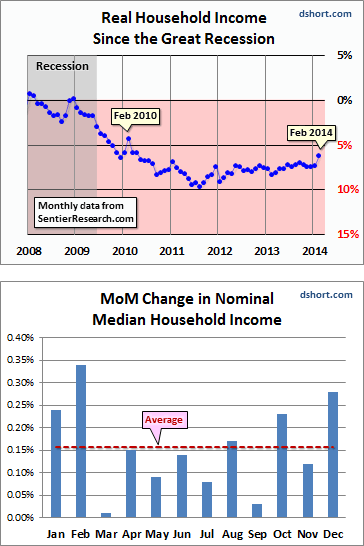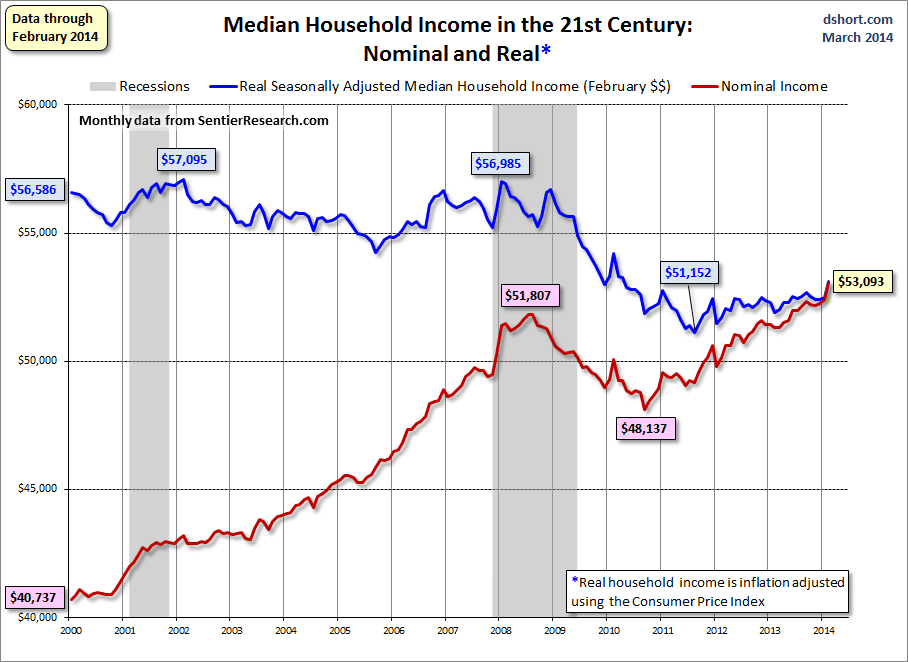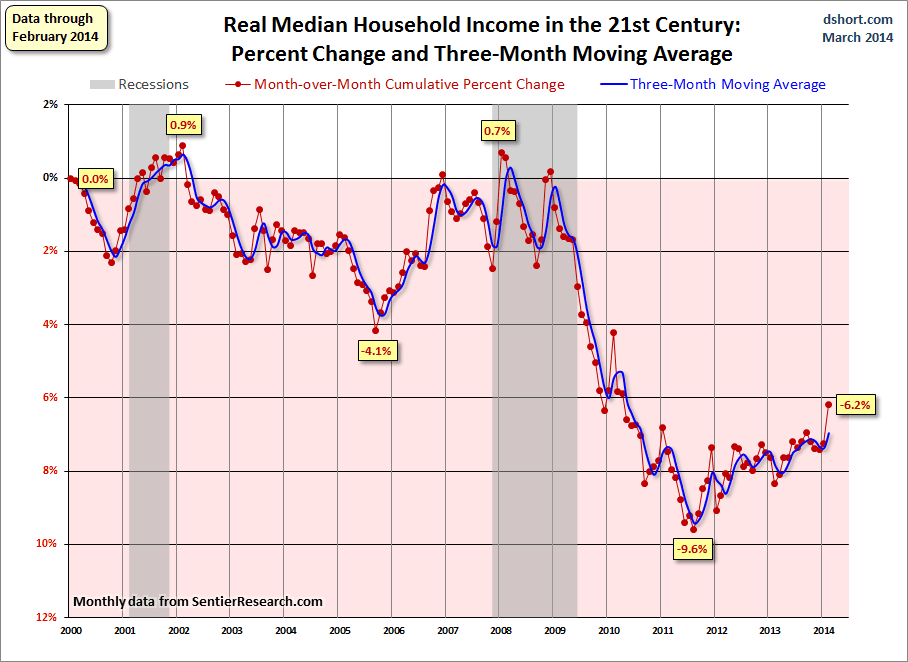Summary: The Sentier Research monthly median household income data series is now available for February. Nominal median household incomes were up $668 month-over-month and up $1,787 year-over-year. Adjusted for inflation, they were up 1.2% MoM and 2.4% YoY.
The latest monthly gain was the second largest of the 170 data points in this series since the turn of the century. However, in real dollar terms, the median annual income is 6.8% lower (about $3,892) than its interim high in January 2008.
The traditional source of household income data is the Census Bureau, which publishes annual household income data in mid-September for the previous year.
Sentier Research, an organization that focuses on income and demographics, offers a more up-to-date glimpse of household incomes by accessing the Census Bureau data and publishing monthly updates. Sentier Research has now released its most recent update, data through January (available here). The data in their report differs from the Census Bureau's data in three key respects:
- It is a monthly rather than annual series, which gives a more granular view of trends.
- Their numbers are more current. The Census Bureau's 2012 data will remain its latest until September 2014.
- Sentier Research uses the more familiar Consumer Price Index (CPI) for the inflation adjustment. The Census Bureau uses the little-known CPI-U-RS (RS stands for "research series") as the deflator for their annual data. For more on that topic, see this commentary.
The first chart below is an overlay of the nominal values and real monthly values chained in January 2014 dollars. The red line illustrates the history of nominal median household, and the blue line shows the real (inflation-adjusted value). I've added callouts to show specific nominal and real monthly values for January 2000 start date and the peak and post-peak troughs.
This monthly increase in median household income between January and February 2014 extends an uneven but upward trend. Our time series charts clearly illustrate that although the economic recovery officially began in June 2009, the recovery in household income did not begin to emerge until after August 2011. While many of the month-to-month changes in median income since the low-point in August 2011 have not been statistically significant, an overall upward trend is clearly evident.
As for the data itself, Sentier makes it available in Excel format for a small fee (here). I have used the latest data to create a pair of charts illustrating the nominal and real income trends during the 21st century.
The blue line in the chart above paints the less optimistic "real" picture. Since we've chained in February 2014 dollars and the overall timeframe has been inflationary, the earlier monthly values are adjusted upward accordingly. In addition to the obvious difference in earlier real values, we can also see that real incomes peaked before the nominal (January of 2008, one month after the recession began, versus July 2008). Also the real post-recession decline bottomed later than the nominal (August 2011 versus September 2010).
The next chart is my preferred way to show the nominal and real household income -- the percent change over time. Essentially I have taken the monthly series for both the nominal and real household incomes and divided them by their respective values at the beginning of 2000. The advantage to this approach is that it clearly quantifies the changes in both series and avoids a common distraction of using dollar amounts ("How does my household stack up?").

The stunning reality illustrated here is that the real median household income series spent most of the first nine years of the 21st century struggling slightly below its purchasing power at the turn of the century. Real incomes (the blue line) hit an interim peak at a fractional 0.7% in early 2008, far below the nominal illusionary peak (as in money illusion) of 27.2% six months later and now at 30.3%, an all-time high. In contrast, the real recovery from the trough has been depressingly slight, although at first blush the latest monthly data, as I mentioned above, is the second largest of the century so far.

Let's take a closer look at the monthly data since the end of the Great Recession. The adjacent chart highlights the real monthly median values since 2008. The right axis shows the same scale as the chart above -- the percent change from the real household income value at the start of the 21st century. The February 2014 real median annual income is 6.2% below our turn-of-the-century starting point and 6.9% below is 21st century high in January 2008. Note, however, that the Sentier calculations are based on pre-tax data. The expiration of the 2% FICA tax cut in December of 2012 put an additional hit on disposable incomes, especially for those household on tight budgets.
Is there seasonality to the monthly data? The column chart shows the monthly averages of nominal month-over-month change since 2000. Note that February has the biggest average monthly increase. I mentioned above that the February 2014 MoM gain was the second largest of the century. The largest was the 1.6% pop in February 2010, which in retrospect was a conspicuous outlier. Let's hope this past month is a more statistically relevant indication of the trend.
In Summary...
As the excellent data from Sentier Research makes clear, the mainstream U.S. household was struggling before the Great Recession. At this point, real household incomes are in worse shape than they were four years ago when the recession ended.
I'll close this update with another look at real growth, highlighting the actual monthly data points and adding a three-month moving average. The MA trend has been slowly zigzagging higher since the trough in 2011.


